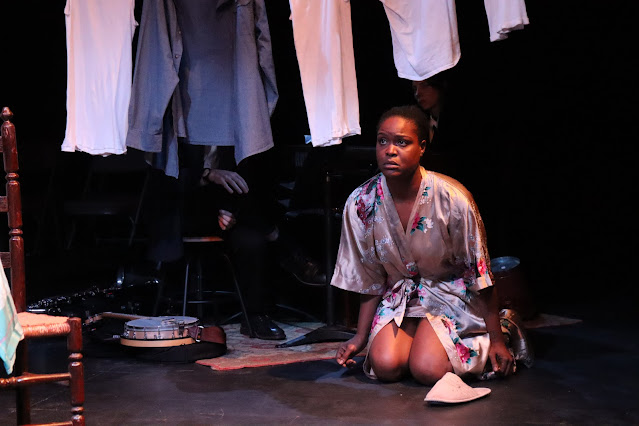A Venomous Color: Burbank
Written by Cameron Darwin Bossert
195 E. 3rd Street, Manhattan, NYC
September 6-18, 2022
 |
| L to R: Kelley Lord, Ryan Blackwell, and Cameron Darwin Bossert. Photo by Valerie Terranova |
Burbank, making its world premiere at the wild project, marks the fourth onstage production from Thirdwing, founded by Artistic Director and Burbank playwright Cameron Darwin Bossert. As a hybrid streaming theater company, Thirdwing creates both streaming and in-person offerings, and Burbank, revised and expanded from an earlier streaming version, is the second full-length in-person play in the series A Venomous Color, which focuses on Walt Disney Studios from 1935 through 1941. The first onstage show in A Venomous Color was the outstanding The Fairest, adapted for streaming as Disney Girls, which examined Disney's "Nunnery," a department made up exclusively of women painters and inkers, as they worked to complete Snow White and the Seven Dwarfs (you can read our review here). Disney Girls and an additional scene from Burbank are available on Thirdwing's streaming service (starting at $4.99 per month or $49 per year, subscriptions include access to the streaming platform and tickets to live shows; see Thirdwing's site for details of available membership packages). The title Burbank refers to the new Disney studio made possible by Snow White's success, but the play finds the company in rockier financial times, with Fantasia and Pinocchio having failed to generate similar returns. Into this already strained situation comes a unionization drive by the Screen Cartoonist's Guild, providing the catalyst for Burbank's spellbinding exploration of the collisions and convergences between art and labor, storytellers and shareholders, and creating new worlds while surviving in the real one.
 |
| L to R: Ryan Blackwell and Cameron Darwin Bossert. Photo by Valerie Terranova |
During a pre-Snow White prologue, animator Art Babbitt (Ryan Blackwell) defends himself from criticism by a brand-conscious Walt Disney (Cameron Darwin Bossert) in part by avowing that an artist must start with reality, an aesthetic argument (Walt will later accuse Art of using reality as a crutch) that also resonates with several of the play's other themes. As the play jumps forward to 1941, Walt is facing pressures from, among others, stockholders and his brother Roy, the money guy of the pair, to focus the company on an assembly line of princess pictures rather than advancing the limits of feature-length animation as a medium; and Art is facing trouble in his marriage. Walt brings more trouble Art's way when he tries to enlist him in an effort to forestall Disney's workers joining the Screen Cartoonist's Guild. Art is initially determined not to get involved, but following a chance meeting with Nunnery artist Betty Ann Dunbar (Kelley Lord)—who, in a symbolically weighted tableau, is asleep with the single apple that serves as her lunch (Walt, who will act, from one perspective, as a tempter, later devours a second apple)—both Art and Betty Ann are inexorably forced into deciding where they stand within the intensifying labor dispute. |
| Kelley Lord. Photo by Valerie Terranova |
At the same time that
Burbank calls to mind current unionization conflicts at Starbucks, Amazon, or, in a more direct artistic parallel, in the AAA video game industry, it also conjures a very specific sense of time and place with a wealth of fascinating and seamlessly incorporated historical and industrial details. Betty Ann's willingness, for instance, to take a job with a lower salary than she could otherwise command because it allows her to make art is similarly both generalizable and rooted in its specific historical context, as is Walt's contention that everything he does is in service of the art itself. Walt, in fact, displaces self-analysis at several points onto Mickey Mouse, whom he characterizes as not a bad guy and someone with a good heart who stirs up trouble sometimes. Depth of character realized by superb performances makes it easy to see an element of truth in this view even as it is just as easy to see that Walt is no utopic boss, or to recognize room for sympathy with Betty Ann's desire to be selfish when choosing between her own dreams and the collective good. Bossert creates an indelible Walt whose passion teeters consistently on the edge of anger, Blackwell as Art traces the nuances of a man working for the gains of others amidst personal losses, and Lord lends Betty Ann both backbone and humor as a woman working to carve her own personal path.
Thirdwing's latest shows that new offices can still mean the same old story when it comes to art and labor relations. But with
Burbank, it's unquestionably a story worth seeing again.
-John R. Ziegler and Leah Richards






Comments
Post a Comment